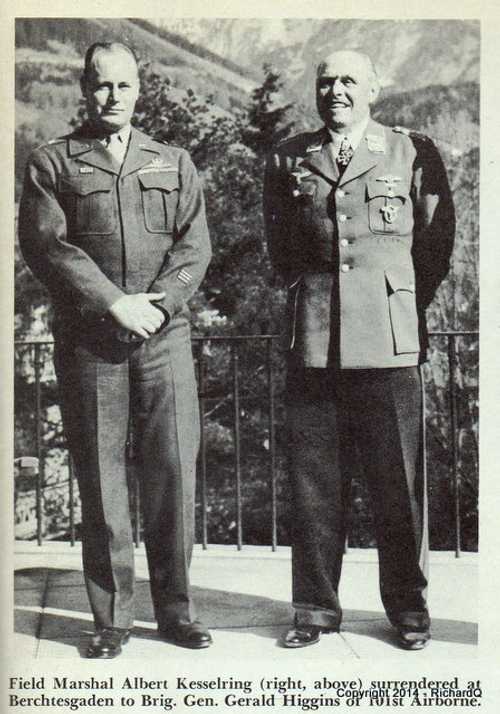
US Army
Nazi who dodged Death
Nazi Field Marshal Albert Kesselring was treated like a celebrity by American generals when he surrendered, with his entire entourage, on May 9, 1945 in Salzburg, Austria. This Signal Corps photo, with with Brig. Gen. Gerald Higgins of the 101st Airborne, was taken later in Berchtesgaden, Bavaria, where they all were quartered in a luxury hotel, and he was allowed to tour the Eastern Front Headquarters , unescorted, while toting his weapons and Marshal's baton and wearing his Nazi decorations. He gave interviews to the American and British media. This was the man who ordered the bombing of defenseless Rotterdam, participated in the planning of the Coventry Blitz bombings, and then headed the Nazi occupation of Italy where Nazi troops killed 46,000 civilians (including about 7,000 Jews). On May 15th his VIP treatment abruptly ended. He landed in prison, shunted through several American POW camps, then worked on a history of WW II for the U.S. Army's Historical Division. In 1946 he was handed to the British military. After testifying at the Nuremberg War Crimes Trials, he was sent to Italy for trial by the English, not the Italians. By 1949 the British had sentenced 230 Nazis to death, including Kesselring. Not one of the sentences was carried out. Churchill himself felt the sentences were too harsh and gave proirity to quick release of war criminals still in custody. Kesselring was released in 1952. He defended the massacre of more than 300 innocent Italians on March 24, 1944, as "a normal military operation" (each person was shot individually in the head while kneeling on the bodies of those killed before). He protested the "unjustly besmirched reputation of German soldiers." The most senior Nazi SS commanders in Italy escaped prosecution. Kesselring went on to write two books before dying of a heart attack at age 74 in Bad Nauheim, West Germany.
3007 Views
5/10/2014
